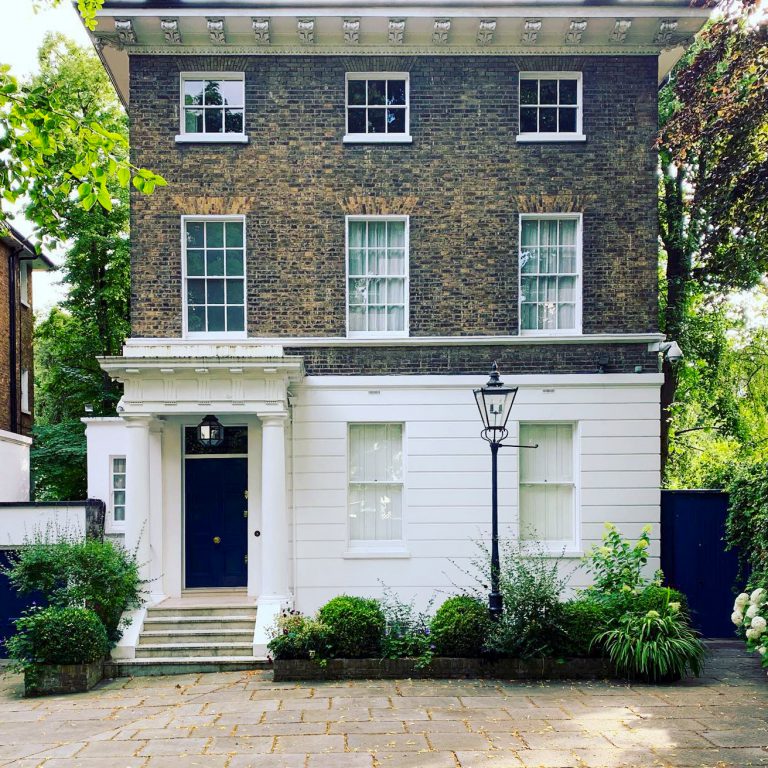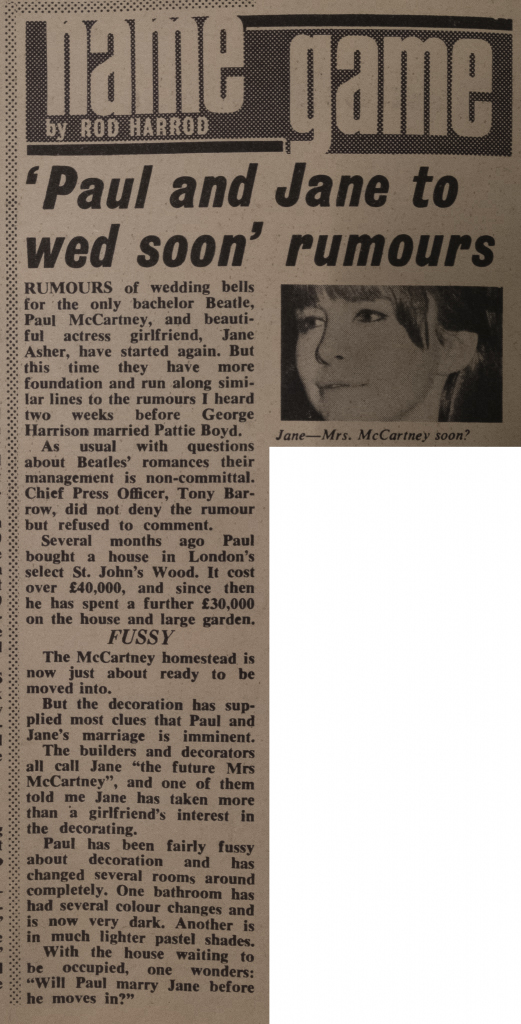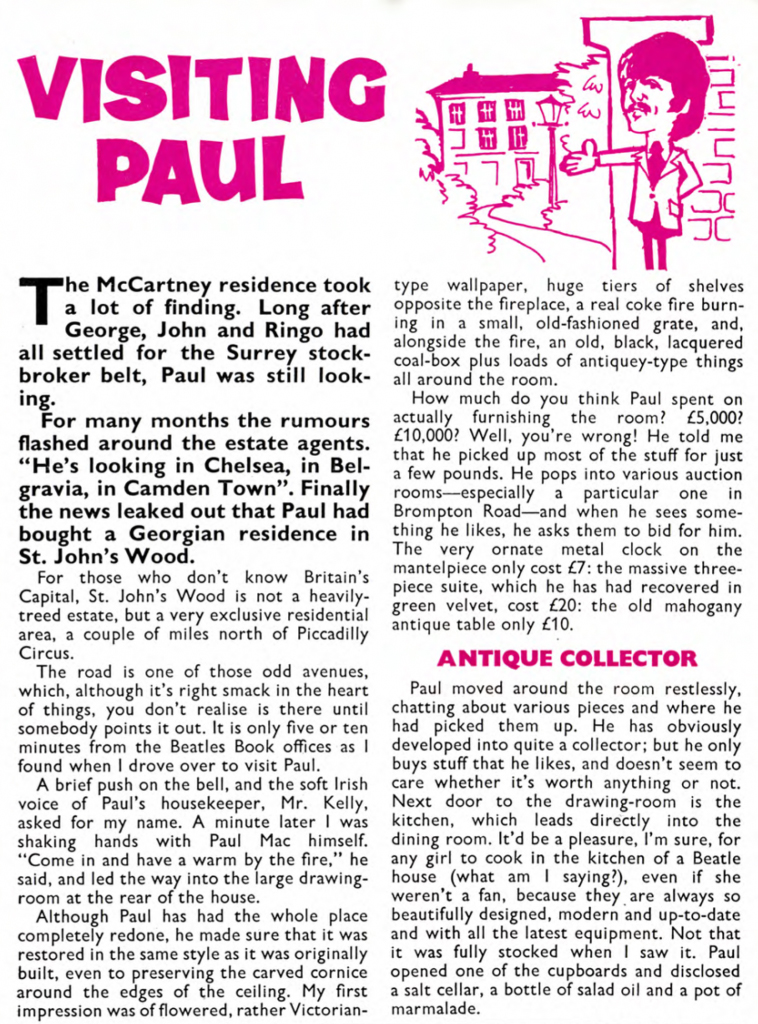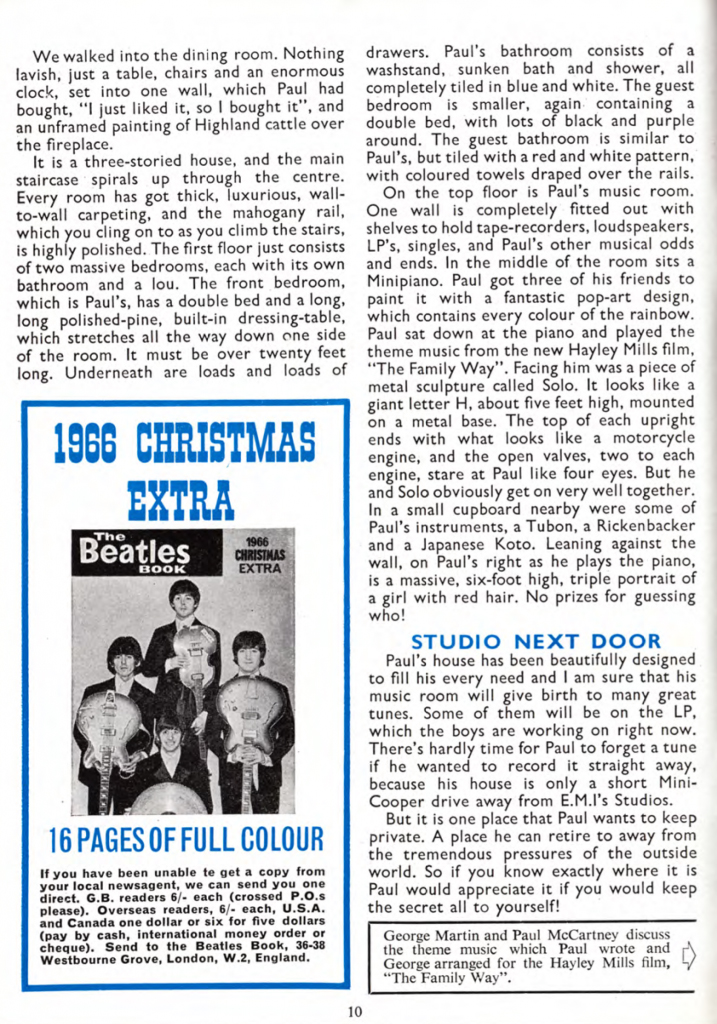
June 1966
Paul McCartney moves to Cavendish Avenue, London
Last updated on November 29, 2023

June 1966
Last updated on November 29, 2023
Location: 7 Cavendish Avenue, St John’s Wood, London, UK
Article May 28, 1966 • The Beatles meet Bob Dylan
Single May 30, 1966 • "Paperback Writer / Rain (US)" by The Beatles released in the US
Article June 1966 • Paul McCartney moves to Cavendish Avenue, London
Article June - July 1966 ? • Designing the "Revolver" cover
Article June 1966 • George Harrison and Paul McCartney meet Ravi Shankar
Late 1966
Dudley Edwards of BEV paints a mural in Paul’s house
Circa January - March 1967
On April 13, 1965, Paul McCartney bought a house at 7 Cavendish Avenue in St John’s Wood, London. After months of refurbishing, he finally moved into this house in June 1966. It would remain his Londonian pied-à-terre for the rest of his life.
Too old to still be living in the guest room at the Ashers’, Paul bought his first house. Distinctly unlike the other Beatles, Paul bought an urban house, on Cavendish Avenue in London’s smart St. John’s Wood. It was a square white Georgian minimanse, protected from the street by high brick walls and electronic gates. The old house had three baths, two guest bedrooms and separate quarters for the couple who came to take care of Paul and Jane’s needs. Instead of turning the decoration over to professionals, they decided to furnish it themselves. They took pleasure in shopping for each piece individually, sometimes buying used furniture at secondhand shops and refinishing it themselves. Paul was proud to point out that the Victorian clock on the mantel cost only £7, and the sofa and armchairs, which he had reupholstered in a bottle green velvet, cost only £20 together. Of course, there was also a gleaming bronze Paolozzi sculpture called “Solo” worth many thousands of pounds and an 1851 clock and a collection of Tiffany glass that were priceless. The floors were covered in deep-pile carpets in sedate tones of brown and gray, and Paul’s bedroom, which faced the front courtyard, had a king-size bed covered in Porthault linens, which were changed almost daily by his loyal housekeeper, Rose. Paul also had a closet built that ran the width of the twenty-two-foot room, which he stocked with the latest fashions from King’s Road and the top tailors. In the master bath, completely tiled in imported blue and white mosaics, he had built a sunken tub big enough for two.
Peter Brown – From “The Love You Make“, 2002
During February, Paul was continuing his musical explorations as well as adding finishing touches to the £40,000 house he’d bought the previous April on Cavendish Avenue, St. John’s Wood, close to EMI Studios, and was having renovated. […] He had brought in John Dunbar’s designer sister, Marina, and her architect husband, John Adams, to redesign the interior of the property. An art school friend of Barry Miles, Pete Simpson, was hired to paint decorative scenes on the cupboard doors in his music room.
From an architect’s point of view, Paul’s demands were basic. He wanted the house renovated as quickly as possible and within a budget of six thousand pounds. There were no major structural changes. He favored hominess over modernity, even to the point of asking Adams to design the ground floor in such a way that the kitchen smells would waft into the living room as they had done at the Ashers’ house (and presumably did at his Liverpool council home). He bought his furniture from auction rooms on Old Brompton Road — a metal clock for seven pounds, a mahogany table for ten pounds, a three-piece suite for twenty pounds. “I don’t go for this modern stuff,” he said. “It always looks as though it needs something doing to it. I like it to be comfortable.” In the basement was an apartment for a couple, the Kellys, who cooked and looked after the house.
During the refurbishment, freshly burned-off paint fell on the wooden floorboards and caused a small fire. When neighbors called the fire department, one of the officers referred to the building as “Paul McCartney’s home,” and the secret of the owner’s identity was out. Not even the construction workers had known whose property they were working on. When the Evening Standard reported it as news, fans turned up and made off with souvenir fixtures and fittings. This resulted in Adams fitting large wooden gates with an expanded metal sheet across the front. It was not only meant to look good, but the rough surface stopped people from writing messages in lipstick and chalk; there was no aerosol paint graffiti in 1966.
From “Beatles ’66: The Revolutionary Year” by Steve Turner
As far as the St. John’s Wood house goes, I’ve furnished it in traditional style because I don’t go for this modern stuff that always looks as if it needs something doing to it. I like it to be comfortable. And those mod leather chairs… ugh. They’re too cold.
Paul McCartney – From interview with New Musical Express, June 24, 1966
It was not until he had his own house that Paul began collecting art. Robert Fraser took an active role in building Paul’s collection. Paul: ‘I was very interested in Magritte and Robert was interested in my interest in Magritte and he said, “Well, I know this gallery owner Iolas who’s his dealer in Paris.”‘ So, some time early in 1966, Paul and Robert flew to Paris. They checked into the Plaza Athenee on the Avenue Montaigne in the heart of haute-couture Paris, one of the most fashionable and snobbish hotels in France. […] Alexandra Iolas was an old friend of Robert’s from the Paris gay scene and had arranged a small dinner party in their honour at his apartment above his gallery on Boulevard St-Germain.
Paul McCartney – From “Paul McCartney: Many Years from Now” by Barry Miles, 1997
PAUL’S NEW HOUSE
Paul is hoping to move into his new London house at the beginning of February. The builders had a set-back a few weeks ago when a fire broke out but luckily it was extinguished before too much damage was done. […]
From The Beatles Monthly Book – February 1966

Neither House Finished Yet
Both Paul and Ringo are still having house trouble. Paul’s new London house was supposed to be ready for him to move in just after last Christmas, but he told us that the decorators are still working there, and it rather looks as if he will not be able to get in until sometime in March. […]
From The Beatles Monthly Book – March 1966

‘Paul and Jane to wed soon’ rumours
RUMOURS of wedding bells for the only bachelor Beatle, Paul McCartney, and beautiful actress girlfriend, Jane Asher, have started again. But this time they have more foundation and run along similar lines to the rumours I heard two weeks before George Harrison married Pattie Boyd.
As usual with questions about Beatles’ romances their management is non-committal. Chief Press Officer, Tony Barrow, did not deny the rumour but refused to comment.
Several months ago Paul bought a house in London’s select St. John’s Wood. It cost over £40,000, and since then he has spent a further £30,000 on the house and large garden.
FUSSY
The McCartney homestead is now just about ready to be moved into.
But the decoration has supplied most clues that Paul and Jane’s marriage is imminent.
The builders and decorators all call Jane “the future Mrs McCartney”, and one of them told me Jane has taken more than a girlfriend’s interest in the decorating.
Paul has been fairly fussy about decoration and has changed several rooms around completely. One bathroom has had several colour changes and is now very dark. Another is in much lighter pastel shades.
With the house waiting to be occupied, one wonders: “Will Paul marry Jane before he moves in?”
From Disc And Music Echo – May 21, 1966

PAUL SETTLES IN
After months of painting and decorating. Paul has moved into his Victorian town house in St. John’s Wood. The furniture, which Paul has carefully picked out himself, is in traditional style (Paul thinks modern furniture is cold and ugly), and when you ask him about the house, he tells you gleefully that he has a lamp-post right outside the front gate! As it will take a lot of looking after, Paul has engaged a married couple from the North of England, who will just, cook, clean and clear up after Paul.
From The Beatles Monthly Book – September 1966

MIKE’S PRESENT
Mike McCartney has given his famous brother lots of small “Alice in Wonderland” figures for his garden. Paul has dotted them all over the place and they certainly give it a very unusual atmosphere. Incidentally, Paul also has a sheepdog puppy, which he calls Martha. Its coat is black and white and it’s got no tail.

VISITING PAUL
The McCartney residence took a lot of finding. Long after George, John and Ringo had all settled for the Surrey stockbroker belt, Paul was still looking.
For many months the rumours flashed around the estate agents. “He’s looking in Chelsea, in Belgravia, in Camden Town”. Finally the news leaked out that Paul had bought a Georgian residence in St. John’s Wood.
For those who don’t know Britain’s Capital. St. John’s Wood is not a heavily-treed estate, but a very exclusive residential area, a couple of miles north of Piccadilly Circus.
The road is one of those odd avenues, which, although it’s right smack in the heart of things, you don’t realise is there until somebody points it out. It is only five or ten minutes from the Beatles Book offices as I found when I drove over to visit Paul.
A brief push on the bell, and the soft Irish voice of Paul’s housekeeper, Mr. Kelly, asked for my name. A minute later I was shaking hands with Paul Mac himself. “Come in and have a warm by the fire,’’ he said, and led the way into the large drawing room at the rear of the house.
Although Paul has had the whole place completely redone, he made sure that it was restored in the same style as it was originally built, even to preserving the carved cornice around the edges of the ceiling. My first impression was of flowered, rather Victorian-type wallpaper, huge tiers of shelves opposite the fireplace, a real coke fire burning in a small, old-fashioned grate, and, alongside the fire, an old, black, lacquered coal-box plus loads of antiquey-type things all around the room.
How much do you think Paul spent on actually furnishing the room? £5,000? £10,000? Well, you’re wrong! He told me that he picked up most of the stuff for just a few pounds. He pops into various auction rooms — especially a particular one in Brompton Road — and when he sees something he likes, he asks them to bid for him. The very ornate metal clock on the mantelpiece only cost £7: the massive three-piece suite, which he has had recovered in green velvet, cost £20: the old mahogany antique table only £10.
ANTIQUE COLLECTOR
Paul moved around the room restlessly, chatting about various pieces and where he had picked them up. He has obviously developed into quite a collector; but he only buys stuff that he likes, and doesn’t seem to care whether it’s worth anything or not. Next door to the drawing-room is the kitchen, which leads directly into the dining room. It’d be a pleasure, I’m sure, for any girl to cook in the kitchen of a Beatle house (what am I saying?), even if she weren’t a fan, because they are always so beautifully designed, modern and up-to-date and with all the latest equipment. Not that it was fully stocked when I saw it. Paul opened one of the cupboards and disclosed a salt cellar, a bottle of salad oil and a pot of marmalade.
We walked into the dining room. Nothing lavish, just a table, chairs and an enormous clock, set into one wall, which Paul had bought, “I just liked it, so I bought it”, and an unframed painting of Highland cattle over the fireplace.
It is a three-storied house, and the main staircase spirals up through the centre. Every room has got thick, luxurious, wall-to-wall carpeting, and the mahogany rail, which you cling on to as you climb the stairs, is highly polished. The first floor just consists of two massive bedrooms, each with its own bathroom and a lou. The front bedroom, which is Paul’s, has a double bed and a long, long polished-pine, built-in dressing-table, which stretches all the way down one side of the room. It must be over twenty feet long. Underneath are loads and loads of
drawers. Paul’s bathroom consists of a washstand, sunken bath and shower, all completely tiled in blue and white. The guest bedroom is smaller, again containing a double bed, with lots of black and purple around. The guest bathroom is similar to Paul’s, but tiled with a red and white pattern, with coloured towels draped over the rails.
On the top floor is Paul’s music room. One wall is completely fitted out with shelves to hold tape-recorders, loudspeakers, LP’s, singles, and Paul’s other musical odds and ends. In the middle of the room sits a Minipiano. Paul got three of his friends to paint it with a fantastic pop-art design, which contains every colour of the rainbow. Paul sat down at the piano and played the theme music from the new Hayley Mills film, “The Family Way”. Facing him was a piece of metal sculpture called Solo. It looks like a giant letter H, about five feet high, mounted on a metal base. The top of each upright ends with what looks like a motorcycle engine, and the open valves, two to each engine, stare at Paul like four eyes. But he and Solo obviously get on very well together. In a small cupboard nearby were some of Paul’s instruments, a Tubon, a Rickenbacker and a Japanese Koto. Leaning against the wall, on Paul’s right as he plays the piano, is a massive, six-foot high, triple portrait of a girl with red hair. No prizes for guessing who!
STUDIO NEXT DOOR
Paul’s house has been beautifully designed to fill his every need and I am sure that his music room will give birth to many great tunes. Some of them will be on the LP, which the boys are working on right now. There’s hardly time for Paul to forget a tune if he wanted to record it straight away, because his house is only a short MiniCooper drive away from E.M.I’s Studios.
But it is one place that Paul wants to keep private. A place he can retire to away from the tremendous pressures of the outside world. So if you know exactly where it is Paul would appreciate it if you would keep the secret all to yourself!
From The Beatles Monthly Book – February 1967


The Beatles Diary Volume 1: The Beatles Years
"With greatly expanded text, this is the most revealing and frank personal 30-year chronicle of the group ever written. Insider Barry Miles covers the Beatles story from childhood to the break-up of the group."
We owe a lot to Barry Miles for the creation of those pages, but you really have to buy this book to get all the details - a day to day chronology of what happened to the four Beatles during the Beatles years!

Notice any inaccuracies on this page? Have additional insights or ideas for new content? Or just want to share your thoughts? We value your feedback! Please use the form below to get in touch with us.